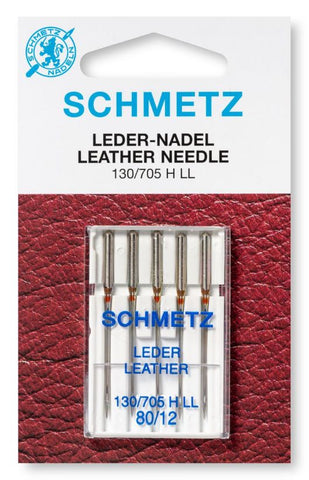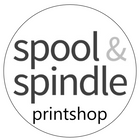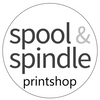Replace Your Sewing Machine Needles
How do I know what sewing machine needle to use?
There is a seemingly dizzying array of needle sizes and types to choose from. We're here to help you choose the perfect needle for your project! We've compiled everything we know about needles into one handy guide below. Our biggest tip? If you're not sure, get a mixed pack or a pack with assorted sizes!
Needle Size
The smaller the size, the smaller the needle. You'll see two numbers on a needle (ie: 80/12, 75/11). One is the European size (which ranges from 60 to 110) and one is the American size (ranges from 8 to 18). You'll want a higher number for heavier fabric, and a lower number for lighter fabric. Usually, for dressmaking and most garments, an 80/12 is ideal; but if you're skipping stitches, getting pulls in the fabric, or the stitches don't look even, it's time to switch sizes (and possibly needle type).
When to change your needle...
Best practice is to change your needle every project, or every 8 hours of sewing time. If you're skipping stitches or the fabric isn't being pierced cleanly, it may be time to change your need. If your needle hits anything, even if it doesn't look bent, you should change it; once it has hit anything hard while sewing, it's more likely to break, which could hurt you or your machine.
Basic Needle Types
These are the needles we reach for the most - they'll work on the widest range of fabrics and are great basics to have in your sewing kit.
UNIVERSAL NEEDLE

Does what it says on the tin! This sewing machine needle has a sharp point, and is good for most woven fabrics. It's the basic needle, and probably what your sewing machine came with. Great for all manner of wovens and projects, including:
Brocade, fleece, leather (thin), velvet, seersucker
Batiste, chiffon, organdy, organza, taffeta
Chambray, terry, linen
Crepe, poplin, voile
Chenille
Cord, felt, jacquard, calico
Velour, wool/wool-mix fabric
Tulle, viscose, panne velvet, half-linen
Lavable, nylon, loden
BALL POINT / JERSEY NEEDLE

This needle has a medium ball point. It's designed to be used with knits and some stretch fabrics. The ball point does not damage knits (it gently pushes the threads of the fabric to one side as it sews) so no runs are created in the stitching. The size should be changed according the the weight of your fabric (use a heavier needle for a heavier fabric).
Suggested fabrics include:
lycra, knitted fabrics, corsetry fabrics, sweatshirt fabric, faux fur
Gauze, jersey, tulle
Imitation fur (funfur), reversible, knitted fabric
JEAN / DENIM NEEDLE

This needle features a modified point and is reinforced for strength. Made to stitch through extra thick woven fabrics without needle deflection and breakage. Use with:
Jeans
Twill
Canvas
MICROTEX NEEDLE

This needle has a very slim and sharp point. It's great for precision sewing due to it's slim silhouette, and made to glide smoothly through dense or fine fabrics. If your universal needle is pulling the weave of your fabric, this is probably the needle you want. Use it for:
Silk and microfiber fabric, Cupro
Lining taffeta
Lamé
For coated materials like foil, oilcoth and synthetic leather
TWIN NEEDLE

This is two needles (or three) attached together; you run two top threads and one bobbin. The needle creates two stitching lines perfectly spaced on top, and a zigzag shape on the underside. Available in Universal, Stretch, Jeans, Metallic, Embroidery, and Hemstitch. Perfect for hems, necklines, and anywhere you need a double line of stitching. It's important to choose the correct needle size and type, as these needles are especially prone to breakage. Available in a variety of widths.
Specialty Needles + Specific Use
If you're using a specialty fabric, or having some troubles with skipped stitches or fabric pulling, you probably need one of the needles below.
STRETCH NEEDLE

This needle features a medium ball point, and an adapted eye and scarf shape that help prevent skipped stitches (it's flatter and sits closer to the hook). It's designed for:
Elastic or highly elastic knitted fabric
The more elastic the material, the more suited the stretch needle is (if in doubt, use the stretch needle).
Swimwear fabrics
Fine jersey, silk jersey, single jersey, velour cloth
Cotton knitwear
TOPSTITCH NEEDLE

This needle features an extra long eye to accommodate and protect heavier threads from breakage. It creates a very straight stitch line. Use it for:
a wide range of woven fabrics (linens, cottons, quilting fabrics, canvas, and more)
The long eye makes it particularly suited for patchwork/quilting and anywhere where thick threads are used.
LEATHER NEEDLE

The point on this needle features a cutting blade, to help the needle penetrate heavy leathers and synthetic leathers. Can also be used on boiled wool or felted wool. Do not use it on knits or wovens, as it is designed to cut a hole as it sews. Best for:
Leather
Hard synthetic leather (only limited suitability with soft synthetic leather: Try the Microtex Needle first, as the carrier material may otherwise be damaged and holes could tear more easily).
Paper (for processing thin brochures)
METALLIC NEEDLE

This needle has an elongated eye and it intended for use with delicate metallic threads. The eye helps keep these threads from shedding and breaking. If you're having trouble with this needle, try a topstitch needle instead.
Sew foil-like metallic threads.
Metallic embroidery or effect yarns should always be processed slowly so that the thread does not break.
HEMSTITCH NEEDLE

This needle has a wide silhouette, with "wings" on either side. Use it on light or medium weight, loosely woven cottons and linens to create decorative cutwork.
Give simple blouses a special effect along the buttonhole placket.
Create embroidery motifs on your embroidery machine.
Conjure up decorative effects when attaching lace.
Prevent seam puckering on soft/light fabrics by using spray starch or a non-permanent stabilizer such as tear-off embroidery backing or water-soluble or heat-sensitive embroidery film.
EMBROIDERY NEEDLE

This needle has a slight ball point, and and extremely wide eye and and a large groove on the shaft. These features help guard against friction to protect fragile threads from breakage. For use with rayon, polyester and embroidery threads.
Use the Embroidery Needle to sew decorative stitches with household sewing machines.
Use embroidery or effect yarns for embroidery using a decorative technique.
You can also use the Embroidery Needle on embroidery machines.
QUILTING NEEDLE

This needle has a special taper and a slightly rounded tip. It's been designed specifically for piecing and machine quilting. The tapered design allows the needle to pierce the fabric more easily to eliminate skipped stitches. Use for:
Cotton fabrics for patchwork, topstitching and quilt work
VINYL NEEDLES

This needle features an anti-adhesive coating, extra large eye, distinctive scarf and reinforced blade to prevent skipped stitches. The anti-adhesive finish reduces residue on your needle when sewing fusibles. Use with:
Vinyl, laminated cotton, oilcloth
embroidery stabilizer
temporary spray adhesive
fusibles
FLEECE NEEDLES

This needle features a medium ball point, specially designed eye, and scarf prevent skipped stitches. Use with:
bulky, plush & highly elastic fabrics.
MIXED PACKS
These packs are absolutely wonderful to have on hand for future projects, or if you aren't sure exactly what kind of needle you'll need. Costume packs contain a variety of garment appropriate needles, as well as a twin needle, meaning you can complete a variety of projects, or a project with a variety of fabrics in it. While they're theoretically meant for costuming and cosplay, they're very handy to have on hand for all garment makers.
Other packs of mixed needles tend to be grouped by intended project; Knit + Stretch Packs, Piecing + Quilting Packs, Home Dec + Upholstery packs, and Felt + Craft Needles. These contain a variety of sizes and styles appropriate to the project, so you don't have to buy several different packs at once.
I have a needle, how do I know what it is?
If it's a Schmetz sewing machine needle, they all are colour coded. The top band indicated the needle type, and the bottom band indicates the size. Schmetz provides a handy chart for reference!

It may seem like a lot of information to take in, but before long it won't seem so overwhelming. Just remember that different fabrics do best with needles designed specifically for them; so if you're having some troubles, it might just be that you need a different sewing machine needle.

